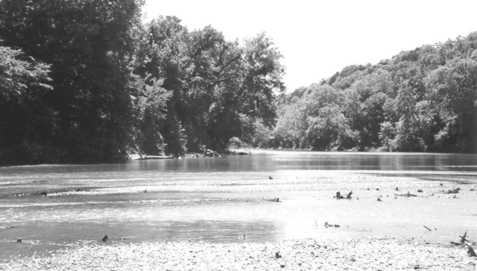SierraScape June - July 2003
Back to Table of Contents
by Dorothy K. Stade
August 8, 1978...Do you remember the day the voters said NO to the Meramec Dam by an almost 2 to 1 margin (64 to 36%)?
The Meramec Dam was the keystone in a huge Meramec River Basin Project which called for dams on the Meramec, Big, and Bourbeuse Rivers, a series of smaller dams on tributaries, and small flood-control dams higher in the basin, for a total of 31 dams. First proposed in the 1930s, no forward movement occurred until the late 1950s when an organization called the Meramec Basin Association was formed. Its primary purpose was lobbying the U.S. Army Corps of Engineers to get them involved in dam building in the Meramec Basin. Their efforts paid off in 1966 when Congress authorized the Plan and began appropriating funds for planning and land purchase.
Not everyone supported the Meramec Plan. Local residents in the Bourbon/Sullivan area formed the Citizens' Committee to Save the Meramec; canoeists, cavers, float fishermen, and others opposed the Meramec Dam. The Coalition for the Environment took an anti-dam position in 1969, but there was not really well-organized opposition to the project, and the Corps moved forward. Appropriations were being made in Congress annually, and the project seemed to be gathering speed.
Enter Jerry Sugerman. Jerry decided that a free-flowing Meramec, Huzzah and Courtois were much more valuable than a reservoir, and in 1971 he committed himself to stopping the Meramec Dam and saving the river. Neither he, nor anyone else, could have imagined it would take ten years.

| |
| The Meramec River at the Shaw Nature Reserve | Photo by John Scott |
Working through the Sierra Club, Jerry Sugerman not only worked with environmentalists, but was able to appeal to a very diverse group of people whom he convinced of the value of the beauty and natural setting of the Meramec Basin. He organized float trips, presented programs and lead a large delegation to Washington D.C. in 1972 to testify against further appropriations for the dam. This was real news because that kind of organized opposition had never appeared before.
Slowly but surely, through the media, through one-on-one meetings with government bureaucrats, through contacts with as many groups as possible who might be affected by the construction of a Meramec Dam, the anti-dam sentiment grew.
By 1975 approximately 22,000 acres had been purchased by the Corps, and some construction work had begun on access roads and administrative facilities. The Corps was ready to begin moving dirt at the dam site. Sugerman and the Sierra Club were not deterred. In 1976 the Meramec Dam became an election issue in several political races, most notably John Danforth's successful race for the U.S. Senate. Danforth built part of his campaign on opposition to the proposed dam and lake. In the presidential race that year, Jimmy Carter pledged to stop the dam's funding, a pledge he kept in 1977 in his first annual budget as President.
The tide was definitely turning, and the anti-dam, pro-river forces were gaining strength. Senator Thomas Eagleton said he would no longer support the Meramec Dam unless a public referendum showed public support for the project. After a great deal of wrangling, the Missouri General Assembly approved a non-binding referendum to be held in the city of St. Louis and 12 Meramec Basin counties on August 8, 1978. Now Sugerman and the Sierra Club really swung into action. With only a few months to organize a coalition of pro-river forces, raise money, organize workers, convince voters, rally supporters, and do a myriad of other things, late spring and early summer passed in a blur, and then it was election day.
And how sweet it was to learn the results of the vote. The voters indicated that free-flowing rivers were of greater value and importance than more flat water recreation, that a natural river and its valley were more appreciated than another impoundment. This is something which would have been thought impossible only a few years earlier when it appeared as if every pro-development interest in the region was lined up in support of the Meramec River Basin Plan.
The final de-authorization of the Meramec Dam in 1981, the dispersal of the lands the Corps had purchased, and the demise of the entire Basin Plan is another story. For now, it is enough to remember August 8, 1978, and celebrate again one of our greatest Sierra Club victories in Missouri.